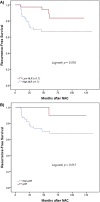Neutrophil-lymphocyte ratio predicts response to chemotherapy in triple-negative breast cancer
- PMID: 29719435
- PMCID: PMC5927790
- DOI: 10.3747/co.25.3888
Neutrophil-lymphocyte ratio predicts response to chemotherapy in triple-negative breast cancer
Abstract
Background: The neutrophil-lymphocyte ratio (nlr) has been reported to correlate with patient outcome in several cancers, including breast cancer. We evaluated whether the nlr can be a predictive factor for pathologic complete response (pcr) after neoadjuvant chemotherapy (nac) in patients with triple-negative breast cancer (tnbc).
Methods: We analyzed the correlation between response to nac and various factors, including the nlr, in 87 patients with tnbc who underwent nac. In addition, we analyzed the association between the nlr and recurrence-free survival (rfs) in patients with tnbc.
Results: Of the 87 patients, 25 (28.7%) achieved a pcr. A high Ki-67 index and a low nlr were significantly associated with pcr. The pcr rate was higher in patients having a high Ki-67 index (≥15%) than in those having a low Ki-67 index (35.7% vs. 0%, p = 0.002) and higher in patients having a low nlr (≤1.7) than in those having a high nlr (42.1% vs. 18.4%, p = 0.018). In multiple logistic analysis, a low nlr remained the only predictive factor for pcr (odds ratio: 4.274; p = 0.008). In the survival analysis, the rfs was significantly higher in the low nlr group than in the high nlr group (5-year rfs rate: 83.7% vs. 66.9%; log-rank p = 0.016).
Conclusions: Our findings that the nlr is a predictor of pcr to nac and also a prognosticator of recurrence suggest an association between response to chemotherapy and inflammation in patients with tnbc. The pretreatment nlr can be a useful predictive and prognostic marker in patients with tnbc scheduled for nac.
Keywords: Triple-negative breast cancer; neoadjuvant chemotherapy; neutrophil–lymphocyte ratio; pathologic complete response; recurrence-free survival.
Figures
References
-
- Wolmark N, Wang J, Mamounas E, Bryant J, Fisher B. Preoperative chemotherapy in patients with operable breast cancer: nine-year results from National Surgical Adjuvant Breast and Bowel Project B-18. J Natl Cancer Inst Monogr. 2001;30:96–102. doi: 10.1093/oxfordjournals.jncimonographs.a003469. - DOI - PubMed
Publication types
MeSH terms
Substances
LinkOut - more resources
Full Text Sources
Other Literature Sources



